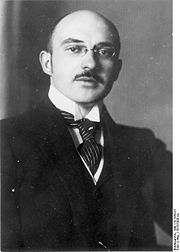
Ludwig Maximilian Erwin von Scheubner-Richter
Encyclopedia

Ludwig Maximilian Erwin von Scheubner-Richter or Max Scheubner-Richter, born Ludwig Maximilian Erwin Richter (9 January 1884 – 9 November 1923) was an early member of the Nazi party. It was Scheubner-Richter along with Alfred Rosenberg
Alfred Rosenberg
' was an early and intellectually influential member of the Nazi Party. Rosenberg was first introduced to Adolf Hitler by Dietrich Eckart; he later held several important posts in the Nazi government...
who devised the plan to drive the German government to revolution through the Beer Hall Putsch
Beer Hall Putsch
The Beer Hall Putsch was a failed attempt at revolution that occurred between the evening of 8 November and the early afternoon of 9 November 1923, when Nazi Party leader Adolf Hitler, Generalquartiermeister Erich Ludendorff, and other heads of the Kampfbund unsuccessfully tried to seize power...
.
Scheubner-Richter was a Baltic German
Baltic German
The Baltic Germans were mostly ethnically German inhabitants of the eastern shore of the Baltic Sea, which today form the countries of Estonia and Latvia. The Baltic German population never made up more than 10% of the total. They formed the social, commercial, political and cultural élite in...
born in Riga
Riga
Riga is the capital and largest city of Latvia. With 702,891 inhabitants Riga is the largest city of the Baltic states, one of the largest cities in Northern Europe and home to more than one third of Latvia's population. The city is an important seaport and a major industrial, commercial,...
, Livonia
Livonia
Livonia is a historic region along the eastern shores of the Baltic Sea. It was once the land of the Finnic Livonians inhabiting the principal ancient Livonian County Metsepole with its center at Turaida...
and lived a large part of his life in Imperial Russia
Russian Empire
The Russian Empire was a state that existed from 1721 until the Russian Revolution of 1917. It was the successor to the Tsardom of Russia and the predecessor of the Soviet Union...
. During the Russian Revolution of 1905
Russian Revolution of 1905
The 1905 Russian Revolution was a wave of mass political and social unrest that spread through vast areas of the Russian Empire. Some of it was directed against the government, while some was undirected. It included worker strikes, peasant unrest, and military mutinies...
he belonged to one of the private armies set up to fight against the revolutionaries. He married the daughter of a manufacturer whose factory he had guarded. The 'Scheubner' in his surname was prefixed to his own from his wife's family name: an old German form of having one's lineage ennobled. During the First World War, he served in Ottoman Turkey as the German vice consul
Vice Consul
A vice consul is a subordinate officer, authorized to exercise consular functions in some particular part of a district controlled by a consulate....
of Erzerum. In addition to holding that post, Scheubner-Richter documented the Turkish massacres of Armenians
Armenians
Armenian people or Armenians are a nation and ethnic group native to the Armenian Highland.The largest concentration is in Armenia having a nearly-homogeneous population with 97.9% or 3,145,354 being ethnic Armenian....
as part of the Armenian Genocide
Armenian Genocide
The Armenian Genocide—also known as the Armenian Holocaust, the Armenian Massacres and, by Armenians, as the Great Crime—refers to the deliberate and systematic destruction of the Armenian population of the Ottoman Empire during and just after World War I...
.
After the war he was involved in the Russian counter-revolution. Scheubner-Richter moved to Germany from Russia along with Alfred Rosenberg
Alfred Rosenberg
' was an early and intellectually influential member of the Nazi Party. Rosenberg was first introduced to Adolf Hitler by Dietrich Eckart; he later held several important posts in the Nazi government...
in 1918. He was the leader of the Aufbau Vereinigung
Aufbau Vereinigung
Aufbau Vereinigung was a Munich based counterrevolutionary conspiratorial group formed in the aftermath of The German occupation of the Ukraine in 1918 and the Latvian Intervention of 1919, composed of White Russian émigrés and early German National Socialists...
, a conspiratorial organisation, composed of White Russian
White movement
The White movement and its military arm the White Army - known as the White Guard or the Whites - was a loose confederation of Anti-Communist forces.The movement comprised one of the politico-military Russian forces who fought...
émigrés and Völkisch minded German National Socialists.
At the end of September 1923, Scheubner-Richter provided Hitler with a lengthy plan for revolution, writing: "The national revolution must not precede the seizure of political power; the seizure of the state's police power constitutes the promise for the national revolution" and "to lay hands on the state police power in a way that is at least outwardly legal".
During the Beer Hall Putsch, walking arm-in-arm with Hitler, he was shot in the lungs and died instantly as Hitler and others marched toward armed guards on 9 November 1923. He had brought Hitler down and dislocated Hitler's shoulder when he fell. He was the only first-tier Nazi leader to die during the Putsch. Of all the early party members who died in the Putsch, Adolf Hitler had claimed Scheubner-Richter to be the only "irreplaceable loss". The first part of Hitler's book "Mein Kampf
Mein Kampf
Mein Kampf is a book written by Nazi leader Adolf Hitler. It combines elements of autobiography with an exposition of Hitler's political ideology. Volume 1 of Mein Kampf was published in 1925 and Volume 2 in 1926...
" is dedicated to Scheubner-Richter and the other fifteen men who died in the Putsch.

